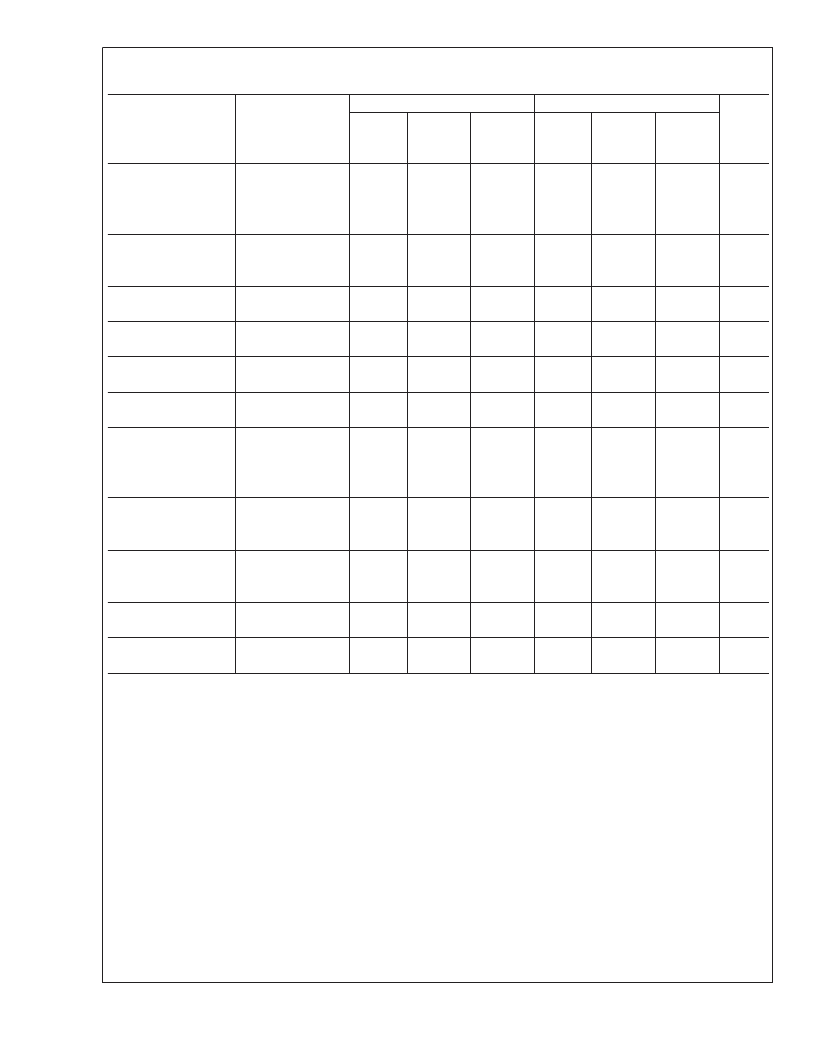- 您現在的位置:買賣IC網 > PDF目錄369787 > LM35 PDF資料下載
參數資料
| 型號: | LM35 |
| 文件頁數: | 4/13頁 |
| 文件大?。?/td> | 303K |
| 代理商: | LM35 |

Electrical Characteristics
(Notes 1, 6)
LM35
Tested
Limit
(Note 4)
±
1.0
LM35C, LM35D
Tested
Limit
(Note 4)
±
1.0
Parameter
Conditions
Design
Limit
(Note 5)
Design
Limit
(Note 5)
Units
(Max.)
Typical
Typical
Accuracy,
LM35, LM35C
(Note 7)
T
A
=+25C
T
A
=10C
T
A
=T
MAX
T
A
=T
MIN
T
A
=+25C
T
A
=T
MAX
T
A
=T
MIN
T
MIN
≤
T
A
≤
T
MAX
±
0.4
±
0.5
±
0.8
±
0.8
±
0.4
±
0.5
±
0.8
±
0.8
±
0.6
±
0.9
±
0.9
±
0.2
C
C
C
C
C
C
C
C
±
1.5
±
1.5
±
2.0
±
1.5
±
1.5
Accuracy, LM35D
(Note 7)
±
1.5
±
2.0
±
2.0
±
0.5
Nonlinearity
(Note 8)
Sensor Gain
(Average Slope)
Load Regulation
(Note 3) 0
≤
I
L
≤
1 mA
Line Regulation
(Note 3)
Quiescent Current
(Note 9)
±
0.3
±
0.5
T
MIN
≤
T
A
≤
T
MAX
+10.0
+9.8,
+10.2
±
2.0
+10.0
+9.8,
+10.2
mV/C
T
A
=+25C
T
MIN
≤
T
A
≤
T
MAX
T
A
=+25C
4V
≤
V
S
≤
30V
V
S
=+5V, +25C
V
S
=+5V
V
S
=+30V, +25C
V
S
=+30V
4V
≤
V
S
≤
30V, +25C
4V
≤
V
S
≤
30V
±
0.4
±
0.5
±
0.01
±
0.02
56
105
56.2
105.5
0.2
0.5
±
0.4
±
0.5
±
0.01
±
0.02
56
91
56.2
91.5
0.2
0.5
±
2.0
mV/mA
mV/mA
mV/V
mV/V
μA
μA
μA
μA
μA
μA
±
5.0
±
5.0
±
0.1
±
0.1
±
0.2
±
0.2
80
80
158
138
82
82
161
141
Change of
Quiescent Current
(Note 3)
Temperature
Coefficient of
Quiescent Current
Minimum Temperature
for Rated Accuracy
Long Term Stability
2.0
2.0
3.0
3.0
+0.39
+0.7
+0.39
+0.7
μA/C
In circuit of
Figure 1 I
L
=0
T
J
=T
MAX
, for
1000 hours
+1.5
+2.0
+1.5
+2.0
C
±
0.08
±
0.08
C
Note 1:
Unless otherwise noted, these specifications apply: 55C
≤
T
≤
+150C for the LM35 and LM35A; 40
≤
T
≤
+110C for the LM35C and LM35CA; and
0
≤
T
≤
+100C for the LM35D. V
=+5Vdc and I
=50 μA, in the circuit of Figure 2 These specifications also apply from +2C to T
MAX
in the circuit of Figure 1
Specifications in
boldface
apply over the full rated temperature range.
Note 2:
Thermal resistance of the TO-46 package is 400C/W, junction to ambient, and 24C/W junction to case. Thermal resistance of the TO-92 package is
180C/W junction to ambient. Thermal resistance of the small outline molded package is 220C/W junction to ambient. Thermal resistance of the TO-220 package
is 90C/W junction to ambient. For additional thermal resistance information see table in the Applications section.
Note 3:
Regulation is measured at constant junction temperature, using pulse testing with a low duty cycle. Changes in output due to heating effects can be
computed by multiplying the internal dissipation by the thermal resistance.
Note 4:
Tested Limits are guaranteed and 100% tested in production.
Note 5:
Design Limits are guaranteed (but not 100% production tested) over the indicated temperature and supply voltage ranges. These limits are not used to
calculate outgoing quality levels.
Note 6:
Specifications in
boldface
apply over the full rated temperature range.
Note 7:
Accuracy is defined as the error between the output voltage and 10mv/C times the device’s case temperature, at specified conditions of voltage, current,
and temperature (expressed in C).
Note 8:
Nonlinearity is defined as the deviation of the output-voltage-versus-temperature curve from the best-fit straight line, over the device’s rated temperature
range.
Note 9:
Quiescent current is defined in the circuit of Figure 1
Note 10:
Absolute Maximum Ratings indicate limits beyond which damage to the device may occur. DC andAC electrical specifications do not apply when operating
the device beyond its rated operating conditions. See Note 1.
Note 11:
Human body model, 100 pF discharged through a 1.5 k
resistor.
Note 12:
See AN-450 “Surface Mounting Methods and Their Effect on Product Reliability” or the section titled “Surface Mount” found in a current National
Semiconductor Linear Data Book for other methods of soldering surface mount devices.
L
www.national.com
4
相關PDF資料 |
PDF描述 |
|---|---|
| LM360MX | Analog Comparator |
| LM360 | High Speed Differential Comparator |
| LM360H | High Speed Differential Comparator |
| LM360M | High Speed Differential Comparator |
| LM360N | High Speed Differential Comparator |
相關代理商/技術參數 |
參數描述 |
|---|---|
| LM350 | 制造商:FAIRCHILD 制造商全稱:Fairchild Semiconductor 功能描述:3-Terminal 3A Positive Adjustable Voltage Regulator |
| LM350/D | 制造商:未知廠家 制造商全稱:未知廠家 功能描述:Three-Terminal Adjustable Output Positive Voltage Regulator |
| LM350_08 | 制造商:STMICROELECTRONICS 制造商全稱:STMicroelectronics 功能描述:Three-terminal 3 A adjustable voltage regulators |
| LM350_09 | 制造商:FAIRCHILD 制造商全稱:Fairchild Semiconductor 功能描述:3-Terminal 3A Positive Adjustable Voltage Regulator |
| LM3500 | 制造商:NSC 制造商全稱:National Semiconductor 功能描述:Synchronous Step-up DC/DC Converter for White LED |
發(fā)布緊急采購,3分鐘左右您將得到回復。